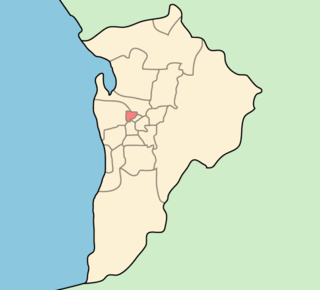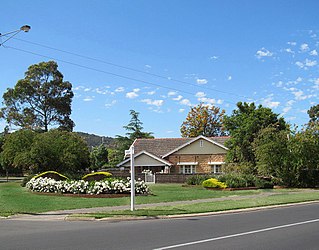
Torrens Park is a mainly residential inner-southern suburb of Adelaide, incorporating some of the foothills and adjacent to the original "Mitcham Village".

Elizabeth is an outer northern suburb of Adelaide, South Australia. It is located in the City of Playford.

Marion is a suburb in the City of Marion, around 10 kilometres (6.2 mi) south-west of the city centre of Adelaide, the capital of South Australia. Founded as a rural village in 1838 on the banks of the Sturt River, Marion was found to have rich soil and the population expanded rapidly. Colonel William Light laid out the plan for the village, as he had done with the City of Adelaide itself.

The garden city movement is a method of urban planning in which self-contained communities are surrounded by "greenbelts", containing proportionate areas of residences, industry, and agriculture. The idea was initiated in 1898 by Sir Ebenezer Howard in the United Kingdom.

The City of Prospect is an inner urban local government area (LGA) in Adelaide, South Australia. The council seat is the unusually-large suburb of Prospect, which makes up almost two thirds of the tiny council area which is less than 8km2. Established in 1872, it is one of the oldest local government bodies in South Australia.

Para Hills is a residential suburb of Adelaide, South Australia. There is a light aircraft airport close to its boundary, and numerous sporting facilities, abundant parks and schools and two medium-sized shopping centres. Most of the suburb is in the City of Salisbury while some is in the City of Tea Tree Gully.

Mawson Lakes is a residential suburb in the City of Salisbury, Adelaide, Australia. Named in honor of Sir Douglas Mawson, it has a census area population of 10,872 people. The suburb is located in the northern suburbs of Adelaide around 12 km north of the Central business district. Much of the suburb was previously known as The Levels, and was a non-residential area, housing a campus of the University of South Australia and Technology Park Adelaide.

Westbourne Park is an inner southern suburb of Adelaide, the State capital of South Australia. The suburb was named after Westbourne, a village in Sussex, England, and was laid out in 1881.

Thebarton, formerly Theberton, is an inner-western suburb of Adelaide, South Australia in the City of West Torrens. The suburb is bounded by the River Torrens to the north, Port Road and Bonython Park to the east, Kintore Street to the south, and South Road to the west.

Darlington is a suburb of Adelaide, South Australia part of which is in the City of Onkaparinga and the City of Marion. For many years, Darlington was the southern entrance to Adelaide's urban area on Main South Road. It hosted many service stations of different brands. It represents the convergence of Flagstaff Road to Main South Road from the south, with Seacombe Road to the west, Diagonal Road to the northwest and Marion Road to the north with South Road continuing northeast.

Clapham, located approximately 8 kilometres (5.0 mi) south of the Adelaide city centre, is a primarily residential suburb situated within the City of Mitcham, incorporating some of the foothills. The suburb is named after Clapham in London, England. Neighbouring suburbs are Colonel Light Gardens, Panorama, Lynton, Torrens Park and Lower Mitcham.

Athol Park is a north-western suburb of Adelaide, South Australia. It is located in the City of Charles Sturt.

John Gunn was the 29th Premier of South Australia, leading the South Australian Branch of the Australian Labor Party to government at the 1924 election.

Adelaide city centre is the innermost locality of Greater Adelaide, the capital city of South Australia. It is known by locals simply as "The City" or "Town" to distinguish it from Greater Adelaide and from the City of Adelaide. The locality is split into two key geographical distinctions: the city "square mile", bordered by North, East, South and West Terraces; and the section of the parklands south of the River Torrens which separates the built up part of the city from the surrounding suburbs and North Adelaide.
Gilberton is an inner northern suburb of Adelaide, South Australia on the northern bank of the River Torrens a short distance from Adelaide’s city centre. It is bounded by the river, Park terrace, Stephen Terrace and Northcote Terrace. The suburb is largely residential with some large and ornate Victorian homes and approximately 2 kilometres (1 mi) of the Torrens Linear Park as its southern boundary. The large homes in the suburb's northern section give it a historic character that is protected by Government planning regulations.

Daw Park is an inner southern suburb of Adelaide, South Australia, in the local government area of the City of Mitcham. The suburb is divided into two parts, with a smaller northern exclave separated from the larger southern part by a section of Colonel Light Gardens. The smaller northern exclave is surrounded by the suburbs of Colonel Light Gardens to the south and east, Cumberland Park to the north and Melrose Park to the west. The southern exclave is surrounded by Pasadena to the south, Melrose Park to the west, and Colonel Light Gardens to the north and east.

Parafield Gardens is a suburb of Adelaide, South Australia. The suburb is largely residential, with a pocket of industrial land in the southwest corner. There are two small shopping centres in the area, one on Salisbury Highway which has a Foodland, and another on Sheperdson Road which has an Independent Grocers of Australia.
















